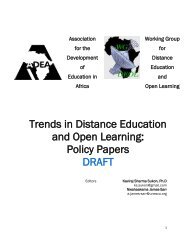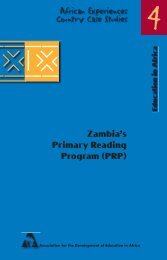Newsletter Vol.16 No.3 - ADEA
Newsletter Vol.16 No.3 - ADEA
Newsletter Vol.16 No.3 - ADEA
Create successful ePaper yourself
Turn your PDF publications into a flip-book with our unique Google optimized e-Paper software.
secondary level. The primary schoolcompletion rate is estimated at 48.3%,and the rate of transition from the lastprimary year to the first secondary yearat 59.6%.These regional averages mask substantialvariations at the country level:the completion rate ranges from 21% to96% from one country to another, andthe primary-secondary transition ratefrom 20% to 90%.These variations (for both the completionrate and the transition rate) explainthe highly contrasting situations ofAfrican countries at the secondary level(see Graph 1. Gross secondary schoolenrollment rates, 1998 and 2001).The secondary school GER is below20% in 15 countries and below 50%in 37 countries. The countrieswith the lowest GERs(6% to 15%) are BurkinaFaso, Burundi, Madagascar,Mozambique, Niger, theCentral African Republic,Tanzania, Chad and Rwanda.At the other end of the scale,those with the highest GERs(61% to 110%) are SouthAfrica, Botswana, CapeVerde, Mauritius, Namibiaand the Seychelles.It is also interesting tonote that most of the 63 millionchildren excluded froment rate (GER) (%)*** Net enrollment rate (NER) (%)***Internal efficiency 2(% of repeaters ingeneral secondaryPrimary- secondaryeducation) transition rate 3 (%)2001 1998 2001 2000 2001 1999 2000M) Total (F/M) Total (F/M) Total (F/M).91 63.7 0.92 51.3 ... 54.9** 0.89 5.1 4.4 90.3 90.8... 90.6 0.99 ... ... 85.0 1.00 1.1 0.3 97.5 98.0.01 105.9 1.02 87.9 1.00 90.0 1.01 .... ... ... 98.9.87 56.6 0.89 ... ... 48.5** 0.85 7.8 7.4 84.3 84.0.88 63.7 0.90 50.8 0.90 55.3 0.92 8.5 8.3 87.7 88.3... 90.1 0.96 ... ... 82.7 0.98 1.4 1.1 97.5 98.3.98 87.1 0.98 81.6 0.98 83.6 0.97 0.3 0.3 97.5 98.0... 68.7 0.93 ... ... ... ... ... ... ... 87.7.09 86.2 1.07 52.9 1.09 63.8 1.06 4.7 4.2 81.5 90.8.01 107.6 1.03 89.4 1.00 89.2 1.01 ... ... ... 99.3.74 48.3 0.79 ... ... ... ... 7.8 ... ... 84.180 26.8 0.79 18.0 0.83 21.3 0.84 15.6 ... 60.4 63.9SCO, 2004, Global EFA Monitoring Report 2005.-olds and the oldest (all countries considered) being 19-year-olds.the education systemare to be found in thepoorest countries,which have verylarge populations.Just 19 countries,having an averageper capita GDPbelow US $400,account for 87% ofthis out-of-schoolpopulation. Fourcountries – Nigeria,Ethiopia, DemocraticRepublic of Congoand Tanzania– accounted for 46%(nearly half) of allchildren actually attendingsecondaryschool.Most of the 63 millionchildren excluded fromthe education system areto be found in the poorestcountries, which have verylarge populations. Just19 countries, having anaverage per capita GDPbelow US$400, account for87% of this out-of-schoolpopulation.Graph 1. Gross secondary school enrollmentrates, in selected sub-Saharan African countries,1998 and 2001Gross enrollment rates120.00100.0080.0060.0040.0020.000.00Low transitionratesRépublic of TanzaniaNigerBurundiBurkina FasoThe average transitionrate between primaryand junior secondaryeducation (63.9% in2000) is substantiallylower than in other regionsof the world. Herealso, however, there arenoteworthy differencesRwandaMozambiqueUgandaChadEthiopiaAngolaZambiaBeninCôte d’IvoireEritreaComorosKenyaLiberiaGambiaLesothoTogoMalawiGhana1998 2001GabonSwazilandNamibiaCape VerdeSource: UNESCO 2004. Figure 3.14, P. 103, Global EFAMonitoring Report 2005.between countries. Some countries arebelow 33% (Burkina Faso, Burundi andCameroon), while others record ratesof over 80% (South Africa, Botswana,Congo, Eritrea, Ethiopia, Gambia,Ghana, Namibia, Seychelles).The problem of internalefficiencyMauritiusBotswanaSouth AfricaSeychellesFor many countries, the data are notavailable. However, the regional averagepercentage of repeaters is, at 15.6%of pupils, much higher than in otherregions, with detrimental effects onnumbers of pupils and on the cost ofsecondary education.▼1. Article based on excerpts from the GlobalEFA Monitoring Report 2005, UNESCO,2004.2. Internal efficiency: The internal efficiency ofsecondary education is not easy to evaluate.The fact that there are a number of differentstreams at this level makes it difficult tofollow the movement of a cohort from oneschool year to the next. As a result, theonly aspect of educational efficiency thatcan be analyzed, on the basis of data fromthe UNESCO Institute for Statistics (UIS),is the percentage of repeaters in generalsecondary education.3. Rate of transition to secondary education:the number of pupils admitted to the firstyear of secondary education during agiven school year, as a percentage of thenumber of pupils enrolled in the last yearof primary education the previous year.<strong>ADEA</strong> <strong>Newsletter</strong> July - September 2004 13
















